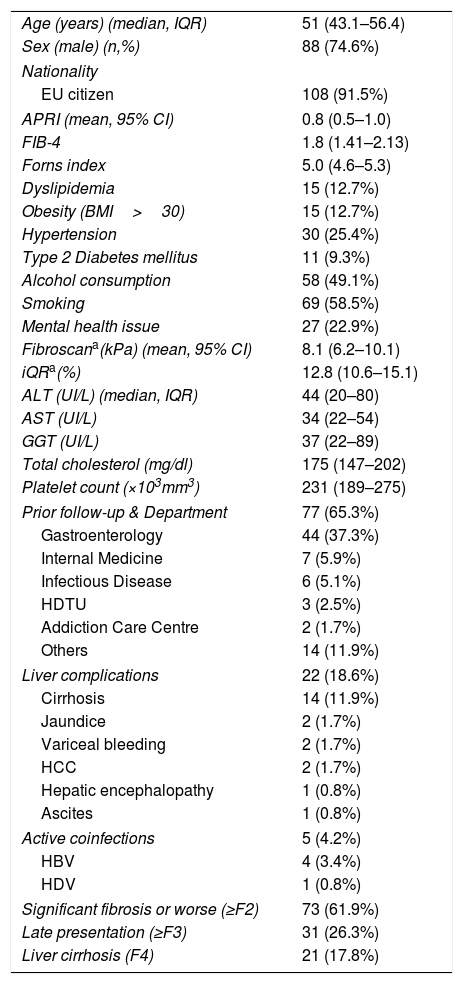It has been proposed that primary care diagnose and treat hepatitis C virus (HCV) infection. However, a care circuit between primary and specialized care based on electronic consultation (EC) can be just as efficient in the micro-elimination of HCV. It is proposed to study characteristics and predictive factors of continuity of care in a circuit between primary and specialized care.
MethodsFrom February/2018 to December/2019, all EC between primary and specialized care were evaluated and those due to HCV were identified. Variables for regression analysis and to identify predictors of completing the care cascade were recorded.
ResultsFrom 8098 EC, 138 were performed by 89 (29%) general practitioners over 118 patients (median 50.8 years; 74.6% men) and were related to HCV (1.9%). Ninety-two patients (78%) were diagnosed>6 months ago, and 26.3% met criteria for late presentation. Overall, 105 patients required assessment by the hepatologist, 82% (n=86) presented for the appointment, of which 67.6% (n=71) were viraemic, 98.6% of known. Finally, 61.9% (n=65) started treatment. Late-presenting status was identified as an independent predictor to complete the care cascade (OR 1.93, CI 1.71–1.99, p<0.001).
ConclusionCommunication pathway between Primary and Specialized Care based on EC is effective in avoiding significant losses of viraemic patients. However, the referral rate is very low, high in late-stage diagnoses, heterogeneous, and low in new diagnoses. Therefore, early detection strategies for HCV infection in primary care are urgently needed.
Se ha propuesto que atención primaria diagnostique y trate la infección por virus de la hepatitis C (VHC). Sin embargo, un circuito asistencial entre atención primaria y especializada basado en la consulta electrónica (CE) puede ser igual de eficiente en la microeliminación del VHC. Se propone estudiar características y factores predictivos de la continuidad asistencial en un circuito entre atención primaria y especializada.
MétodosDesde febrero/2018 y diciembre/2019 se evaluaron todas las CE entre atención primaria y especializada, y se identificaron aquellas por VHC. Se registraron variables para análisis de regresión e identificar factores predictores de completar cascada de atención.
ResultadosDe un total de 8.098 CE, 138 realizadas por 89 (29%) médicos generales de 118 pacientes (mediana de 50,8 años; 74,6% varones) fueron por VHC (1,9%). Noventa y dos pacientes (78%) fueron diagnosticados hace más de 6 meses), y el 26,3% cumplía criterios de presentación tardía. En total, 105 pacientes requirieron valoración por el hepatólogo. El 82% (n=86) se presentaron a la cita, de los cuales el 67,6% (n=71) eran virémicos, el 98,6% de los conocidos. Finalmente, el 61,9% (n=65) inició tratamiento. El estado de presentación tardía se identificó como un factor predictivo independiente para completar la cascada de atención (OR: 1,93; IC 95%: 1,71-1,99; p<0,001).
ConclusiónLa comunicación entre atención primaria y especializada basada en la CE es eficaz para evitar pérdidas significativas de pacientes virémicos. Sin embargo, la tasa de derivación es muy baja, elevada en diagnósticos en fase tardía, heterogénea y escasa en nuevos diagnósticos. Por tanto, se necesitan con urgencia, estrategias de detección precoz de infección por VHC en atención primaria.











